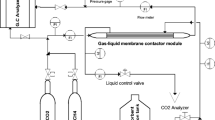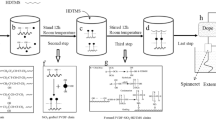Abstract
Microporous PVDF hollow-fiber membranes intended for use in gas absorption were prepared via a dry-wet phase-inversion method. The membranes were characterized in terms of gas permeation, wetting resistance, mass transfer resistance, overall porosity, and outer surface contact angle. When 4 wt% glycerol was used in the polymer dope, FESEM showed that the membrane had an almost sponge-like structure with an ultrathin outer skin layer. High wetting resistance and N2 permeance with an overall porosity of 77 % and a mean pore size of 0.07 μm were observed for the membranes. A gas–liquid membrane contactor module was used to experimentally investigate the effects of the main operating parameters on CO2 absorption with aqueous DEA solution. Increasing the liquid flow rate led to a significant increase in the CO2 absorption flux, whereas increasing the CO2 concentration in the gas feed from 20 % to 100 % barely affected the CO2 flux. These results indicated that the main resistance came from the liquid phase; the resistance of the gas phase was negligible. The results of a long-term experiment indicated that the CO2 flux dropped by 26 % during the initial 10 h, but then remained stable until the end of operation.












Similar content being viewed by others
References
Gabelman A, Hwang ST (1999) Hollow fiber membrane contactors. J Membr Sci 159:61–106
Mansourizadeh A, Ismail AF (2009) Hollow fiber gas–liquid membrane contactors for acid gas capture: a review. J Hazard Mater 171:38–53
Shirazian S, Ashrafizadeh SN (2010) Mass transfer simulation of carbon dioxide absorption in a hollow-fiber membrane contactor. Sep Sci Technol 45:515–524
Al-Marzouqi MH, Marzouk SAM, El-Naas MH, Abdullatif N (2009) CO2 removal from CO2-CH4 gas mixture using different solvents and hollow fiber membranes. Ind Eng Chem Res 48:3600–3605
Mansourizadeh A, Ismail AF, Matsuura T (2010) Effect of operating conditions on the physical and chemical CO2 absorption through the PVDF hollow fiber membrane contactor. J Membr Sci 353:192–200
Mansourizadeh A, Ismail AF (2011) Preparation and characterization of porous PVDF hollow fiber membranes for CO2 absorption: effect of different non-solvent additives in the polymer dope. Int J Greenh Gas Control 5:640–648
Barth D, Tondre C, Delpuech JJ (1984) Kinetics and mechanisms of the reactions of carbon dioxide with alkanolamines: a discussion concerning the cases of MDEA and DEA. Chem Eng Sci 39:1753–1757
Yu WC, Astarita G (1985) Kinetics of carbon dioxide absorption in solutions of methyldiethanolamine. Chem Eng Sci 40:1585–1590
Hoff KA, Juliussen O, Pedersen OF, Svendsen HF (2004) Modeling and experimental study of carbon dioxide absorption in aqueous alkanolamine solutions using a membrane contactor. Ind Eng Chem Res 43:4908–4921
Lu J, Wang L, Sun X, Li J, Liu X (2005) Absorption of CO2 into aqueous solutions of methyldiethanolamine and activated methyldiethanolamine from a gas mixture in a hollow fiber contactor. Ind Eng Chem Res 44:9230–9238
Malek A, Li K, Teo WK (1997) Modeling of microporous hollow fiber membrane modules operated under partially wetted condition. Ind Eng Chem Res 36:784–793
Sukitpaneenit P, Chung TS (2009) Molecular elucidation of morphology and mechanical properties of PVDF hollow fiber membranes from aspects of phase inversion, crystallization and rheology. J Membr Sci 340:192–205
Mansourizadeh A, Ismail AF (2010) Effect of LiCl concentration in the polymer dope on the structure and performance of hydrophobic PVDF hollow fiber membranes for CO2 absorption. Chem Eng J 165:980–988
Ismail AF, Mansourizadeh A (2010) A comparative study on the structure and performance of porous polyvinylidene fluoride and polysulfone hollow fiber membranes for CO2 absorption. J Membr Sci 365:319–328
Ismail AF, Dunkin IR, Gallivan SL, Shilton SJ (1999) Production of super selective polysulfone hollow fiber membranes for gas separation. Polymer 40:6499–6506
Chakrabarty B, Ghoshal AK, Purkait MK (2008) SEM analysis and gas permeability test to characterize polysulfone membrane prepared with polyethylene glycol as additive. J Colloid Interface Sci 320:245–253
Henis JMS, Tripodi MK (1981) Composite hollow fiber membranes for gas separation: the resistance model approach. J Membr Sci 8:233–246
Tasselli F, Jansen JC, Sidari F, Drioli E (2005) Morphology and transport property control of modified poly (ether ether ketone) (PEEKWC) hollow fiber membranes prepared from PEEKWC/PVP blends: influence of the relative humidity in the air gap. J Membr Sci 255:13–22
Wilson EE (1915) A basis for rational design of heat transfer apparatus. Trans ASME 37:47–70
Seo DJ, Hong WH (1996) Solubilities of carbon dioxide in aqueous mixtures of diethanolamine and 2-amino-2-methyl-1-propanol. J Chem Eng Data 41:258–260
Li MH, Chang BC (1994) Solubilities of carbon dioxide in water + monoethanolamine + 2-amino-2-methyl-1-propanol. J Chem Eng Data 39:448–452
Wang D, Li K, Teo WK (2000) Porous PVDF asymmetric hollow fiber membranes prepared with the use of small molecular additives. J Membr Sci 178:13–23
Mulder M (2003) Basic principles of membrane technology. Kluwer, Dordrecht
Han MJ, Nam ST (2002) Thermodynamic and rheological variation in polysulfone solution by PVP and its effect in the preparation of phase inversion membrane. J Membr Sci 202:55–61
Koros WJ, Fleming GK (1993) Membrane-based gas separation. J Membr Sci 83:1–80
Fontananova E, Jansen JC, Cristiano A, Curcio E, Drioli E (2006) Effect of additives in the casting solution on the formation of PVDF membranes. Desalination 192:190–197
Xu A, Yang A, Young S, deMontigny D, Tontiwachwuthikul P (2008) Effect of internal coagulant on effectiveness of polyvinylidene fluoride membrane for carbon dioxide separation and absorption. J Membr Sci 311:153–158
Khayet M, Matsuura T (2003) Determination of surface and bulk pore sizes of flat-sheet and hollow-fiber membranes by atomic force microscopy, gas permeation and solute transport methods. Desalination 158:57–64
Wang R, Zhang HY, Feron PHM, Liang DT (2005) Influence of membrane wetting on CO2 capture in microporous hollow fiber membrane contactors. Sep Purif Technol 46:33–40
Costello MJ, Fane AG, Hogan PA, Schofield RW (1993) The effect of shell side hydrodynamics on the performance of axial flow hollow fiber modules. J Membr Sci 80:1–11
Kim SY, Yang SM (2000) Absorption of carbon dioxide through hollow fiber membranes using various aqueous absorbents. Sep Purif Technol 21:101–109
Wang R, Li DF, Liang DT (2004) Modeling of CO2 capture by three typical amine solutions in hollow fiber membrane contactors. Chem Eng Process 43:849–856
Danckwerts PV (1970) Gas liquid reactions. McGraw-Hill, New York
Versteeg GF, Oyevaar MH (1989) The reaction between CO2 and diethanolamine at 298 K. Chem Eng Sci 44:1264–1268
Mondal MK (2009) Solubility of carbon dioxide in an aqueous blend of diethanolamine and piperazine. J Chem Eng Data 54:2381–2385
Mansourizadeh A, Ismail AF (2011) A developed asymmetric PVDF hollow fiber membrane structure for CO2 absorption. Int J Greenh Gas Control 5:374–380
Fisher LR, Gamble RA, Middlehurst J (1981) The Kelvin equation and the capillary condensation of water. Nature 290:575–576
Hashim NA, Liu Y, Li K (2011) Stability of PVDF hollow fiber membranes in sodium hydroxide aqueous solution. Chem Eng Sci 66:1565–1575
Wang R, Li DF, Zhou C, Liu M, Liang DT (2004) Impact of DEA solutions with and without CO2 loading on porous polypropylene membranes intended for use as contactors. J Membr Sci 229:147–157
Lv Y, Yu X, Tu ST, Yan J, Dahlquist E (2010) Wetting of polypropylene hollow fiber membrane contctors. J Membr Sci 362:444–452
Acknowledgments
The authors gratefully acknowledge the support of the Advanced Membrane Technology Research Center (AMTEC) from Universiti Teknologi Malaysia.
Author information
Authors and Affiliations
Corresponding author
Rights and permissions
About this article
Cite this article
Mansourizadeh, A., Mousavian, S. Structurally developed microporous polyvinylidene fluoride hollow-fiber membranes for CO2 absorption with diethanolamine solution. J Polym Res 20, 99 (2013). https://doi.org/10.1007/s10965-013-0099-3
Received:
Accepted:
Published:
DOI: https://doi.org/10.1007/s10965-013-0099-3




